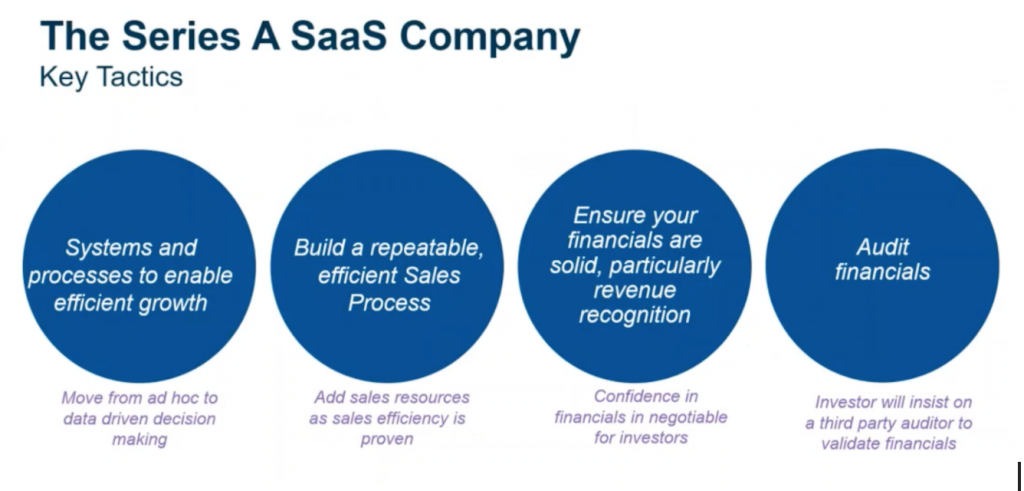After finding initial product-market fit, the next challenge startups face is going from seed stage to growth stage. To grow, startups can’t solely rely on a scrappy team hacking things together. Instead, investors and customers alike want to see a streamlined operation that can handle increased demand.
In a webinar hosted by Sage Intacct, panellists David Appel from Sage Intacct, Tina Gregory from Early Growth Financial Services, Poya Osgouei from Poya Ventures, and Ryan Floyd from Storm Ventures explained the key growth metrics every SaaS startup needs to understand in order to cross that chasm from seed to growth. The panel also explained how startup leaders should think about team building and incentives so that everyone is geared toward the same goal: sustainable growth.
Solving for growth
Early-stage startups only have to prove three key things to move to growth stage: show promising unit economics, build a 2-3 year financial model based on previous growth rates, and plan a repeatable business model that can be easily explained to investors, employees, and candidates alike.
“You have to earn that business month over month, year over year.”
One element of unit economics the panel debated is how much customers should pay upfront. While panellists agreed it’s ideal to have customers pay for a whole year upfront, they were quick to note that this isn’t the reality for most startups. However, Gregory said contract negotiations should start with yearly upfront payments, and negotiate from there.
In Gregory’s view, asking for upfront payment shows you believe you have value and that you are confident customers will love your product. In contrast, not asking for the upfront payment suggests you don’t believe your product can deliver on its promises.
“You really want folks to get to that ‘aha’ point – ‘I can’t live without this solution,’” she said. “Present it that way. Ask to be paid on that contract upfront. You can always modify from there.”
As startup leaders build financial 2-3 year models based on unit economics and previous growth, retention becomes a critical metric. Osgouei said leaders need to think of retention not just in terms of renewals, but also how efficiently you onboard customers after the first purchase.
“If you don’t have a good post-[sales process], getting people to usage, you’re going to hit a churn problem,” Osgouei said.
He also said that regardless of whether or not a customer pays monthly or annually, you need to focus on showing value all the time, not just at the point of purchase or renewal.
“You have to earn that business month over month, year over year,” he said.

The metrics to get you there
“At the beginning, if you’re trying to get to product-market fit, a lot of people make the mistake of focusing too much on revenue,” said Osgouei.
While he clarified that revenue is a critical metric for any startup, Osgouei added that startup leaders need to think more in terms of getting customers to use – and receive value from – your product as soon as possible. If existing customers see value, then it becomes easier to develop a strong value proposition to draw in new customers while keeping the current ones.
In addition to revenue, the panel noted five other key metrics SaaS leaders need to know: leads at each stage of the sales funnel, sales efficiency at each stage in the funnel, churn (especially from early customers), upsell and retention metrics by cohort of when customers came in the door, and gross profits from each customer.
These data points are what Appel referred to as “telling the [company] story with metrics.”
For Floyd, all these metrics come together to evaluate one thing: customer happiness.
“Ultimately SaaS is about customer happiness,” said Floyd. “If you don’t make your customers happier, eventually they are going to churn.”
Floyd went further, saying that founders should not just consider churn but account expansion. His rule of thumb: “if you’re not expanding and growing your accounts, you should just assume they are going to churn.”
While Floyd acknowledged that an assumption of churn is quite severe, he also argued that it’s the best way to measure client happiness in a SaaS environment.
Building the right team structures and incentives
Tracking the right metrics is only one part of crossing the chasm. Startups also need a team able to drive metrics in the right direction, which the panel said requires three elements: developing the right incentives for sales, intimately connecting the finance and sales teams, and documenting processes for scalability.
When building sales team incentives, Osgouei explicitly advised against rewarding salespeople based on sales revenue. Instead, he said, “Reward them for usage. Reward them for making a referral.”
“Reward [salespeople] for usage. Reward them for making a referral.”
The reasoning behind this logic is that if you optimize incentives for revenue, salespeople will do whatever it takes to bring in an extra dollar. While this sounds ideal in a startup, in reality, it leads to salespeople that might bring in bad-fit customers who quickly churn. By incentivizing based on referrals and renewal, salespeople are more likely to focus on bringing in high-quality customers, not just revenue at any cost.
Incentives for usage and referral also help salespeople in the long run. While salespeople are motivated by money and do what they are incentivized to do, they also have their reputations to think about. Osgouei said that with the advent of professional social networks like LinkedIn, a reputation for sleazy sales at one company could follow you throughout your whole career.
Osgouei shared an example of this from his time at HackerRank. He said the company put a unique incentive in place: whoever got a referral got double the commission, whether it was the original client signing up for another year or referring in a net new client. With these incentives, salespeople were geared to focus on the best-fit customers, not just anyone who would sign a contract.
With the right incentives in place, the next step is to ensure everyone understands why startup metrics like cost of acquisition, lifetime value, and sales funnel efficiency matter. Gregory said that many people assume the CFO or finance wants to hinder sales, but that’s not the truth; “[finance] wants to protect the company” and keep cash flowing. As a result, the more sales and finance collaborate and build mutual understanding, the better it is for the business.
Osgouei agreed with this point, adding “one of the most underrated things anybody in finance can do is sit down with everybody – including sales – and teach them the basics.”
Finally, documentation is critical for companies that want to move into the growth stage.
“The number one mistake is that people don’t do enough documentation,” said Osgouei. “They do [the job] but don’t document it for the next person to pick up the mantle.”
The reason why this is important, said Osgouei, is the problem of “hero sales” in early-stage startups. Often, a founder or key early hire will drive a lot of revenue. That works great at the early stages, but Osgouei said investors will want to see how the business can scale with a system, not relying on one person to constantly work their magic.
Recognize the long road
Building a SaaS company can be simple some days and wildly hard the next. As companies move from early stage to growth stage, the challenges only get more difficult. So as SaaS leaders aim to make that jump, Osgouei recommended taking time to recognize and appreciate your people as much as you incentivize and push them to hit their numbers.
“You have to reward them,” said Osgouei. “It doesn’t always have to be commission based. But give them experiences – or a gift card – so they feel appreciated.”
Image courtesy Pixabay.


